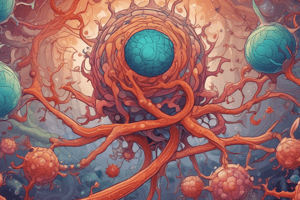Podcast
Questions and Answers
Neutrophils are white blood cells that engulf and destroy bacteria, fungi, and other pathogens.
Neutrophils are white blood cells that engulf and destroy bacteria, fungi, and other pathogens.
True (A)
Natural Killer (NK) cells are part of the adaptive immune response.
Natural Killer (NK) cells are part of the adaptive immune response.
False (B)
Macrophages are cells that directly kill virus-infected cells or cells with altered self-antigens.
Macrophages are cells that directly kill virus-infected cells or cells with altered self-antigens.
False (B)
Dendritic cells sample tissue and initiate innate immune responses.
Dendritic cells sample tissue and initiate innate immune responses.
The Major Histocompatibility Complex (MHC) is a key element in the functioning of the innate immune system.
The Major Histocompatibility Complex (MHC) is a key element in the functioning of the innate immune system.
Innate immunity involves only physical barriers like skin and mucous membranes.
Innate immunity involves only physical barriers like skin and mucous membranes.
MHC molecules are responsible for displaying small pieces of antigens to B cells.
MHC molecules are responsible for displaying small pieces of antigens to B cells.
MHC class I molecules present antigens from extracellular pathogens to CD4+ T cells.
MHC class I molecules present antigens from extracellular pathogens to CD4+ T cells.
The adaptive immune response is activated immediately upon encountering a foreign substance.
The adaptive immune response is activated immediately upon encountering a foreign substance.
B cells produce antibodies that help eliminate pathogens from the body.
B cells produce antibodies that help eliminate pathogens from the body.
Study Notes
Unraveling the Secrets of Immunology: Innate Immunity, MHC, and the Immune System
The human immune system is a complex and interconnected network of cells, tissues, and molecules that protect us from diseases and infections. Within this system, two primary layers shield us: the innate immune response and the adaptive immune response. In this exploration of immunology, we'll delve into the foundational elements of innate immunity, the Major Histocompatibility Complex (MHC), and the immune system's intricate workings.
Innate Immunity: The First Line of Defense
Innate immunity is our body's first line of defense against pathogens. It operates immediately upon encountering a foreign substance, without the need for prior exposure or learning. This quick response is crucial for halting the spread of infection while the adaptive immune system mounts a more targeted defense.
Innate immunity relies on an array of immune cells, including:
- Neutrophils: White blood cells that engulf and destroy bacteria, fungi, and other pathogens.
- Macrophages: Antigen-presenting cells that "eat" pathogens and display their fragments to T cells.
- Natural Killer (NK) cells: Cells that directly kill virus-infected cells or cells with altered self-antigens.
- Dendritic cells: Antigen-presenting cells that sample tissue and initiate adaptive immune responses.
Innate immunity also involves physical and chemical barriers such as the skin and mucous membranes, as well as soluble factors like cytokines and chemokines, which regulate the response to infections.
Major Histocompatibility Complex (MHC)
The Major Histocompatibility Complex (MHC) is a group of cell-surface proteins that play a critical role in adaptive immunity. MHC molecules are responsible for displaying small pieces of antigens (foreign substances) to T cells. This interaction between MHC and T cells is the foundation of the adaptive immune response.
MHC molecules are classified into two main types: MHC class I and MHC class II.
- MHC class I: Found on almost all nucleated cells, MHC class I molecules present antigens derived from intracellular pathogens like viruses to CD8+ T cells.
- MHC class II: Mainly found on antigen-presenting cells like macrophages and dendritic cells, MHC class II molecules present antigens derived from extracellular pathogens to CD4+ T cells.
The interaction between MHC molecules and T cells is crucial for coordinating and regulating the adaptive immune response.
Immune System: A Symphony of Cellular and Molecular Interactions
The immune system is a complex network of cells, tissues, and molecules that work in concert to protect us from infections and diseases. The immune system includes two primary components: the innate immune response and the adaptive immune response.
- Innate immune response: The first line of defense, activated immediately upon encountering a foreign substance.
- Adaptive immune response: A more targeted immune response, involving the activation and clonal expansion of specific T and B cells.
The adaptive immune response is dependent on the recognition of pathogen-derived antigens by T and B cells. This recognition occurs through the interaction of antigens with MHC molecules on the surface of antigen-presenting cells. The adaptive immune response involves two main types of lymphocytes: T cells and B cells.
- T cells: Differentiate into several types of cells, including cytotoxic T cells (CD8+ T cells), helper T cells (CD4+ T cells), and regulatory T cells, which regulate the immune response and maintain immune tolerance.
- B cells: Produce antibodies that neutralize pathogens and help eliminate them from the body.
The immune system's complex and interconnected network of cells, tissues, and molecules ensures our bodies' ability to defend against a wide range of threats and maintain health.
By understanding the foundational elements of innate immunity, MHC, and the immune system, we can appreciate the intricate and interconnected nature of our body's defense against infections and diseases.
Studying That Suits You
Use AI to generate personalized quizzes and flashcards to suit your learning preferences.
Description
Dive into the fundamental aspects of immunology with a focus on innate immunity, Major Histocompatibility Complex (MHC), and the workings of the immune system. Explore the roles of immune cells, the importance of MHC in adaptive immunity, and the orchestration of cellular and molecular interactions in defending against diseases.




